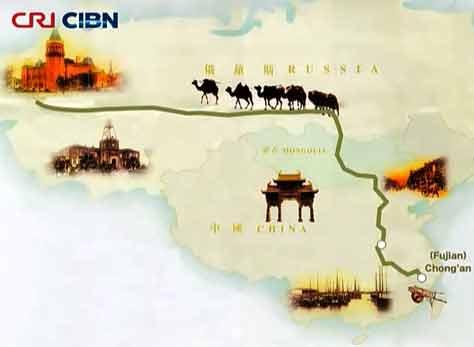No, this has nothing to do with the famous Pet Shop Boys’ song. What? No one else remembers this song? Such a shame. No, this one is not from the Pet Shop Boys but from Talk Talk.
Come on guys, know your classics or perhaps I should get back to tea? I think it is safer if we all agree to take the second option.
Go West is just the physical movement of the tea going from China to Russia, which will be our topic today. As my last post, I wrote this article after reading a book by Martha Avery titled The Tea Road, China and Russia meet across the steppe, a book which gave me a lot of information on this peculiar road (historical, economical,…).
The first recorded Russian experience with tea happened during the first recorded Russian embassy to the Khotogoit in 1638, the Khan made them try a “strong and bitter, green and fragrant” drink and then gave them some to bring back home, hoping to start a profitable business and to earn firearms to deal with the Manchu and the Chinese.
However, some Russian habits like a likeness to drink tea in glasses suggest that they might have had access to tea via the Persians, who drank tea like this and not the Chinese who drink tea in cups. And the first recorded trade agreements with people from this southern tea trade road were recorded during the reign of Ivan IV (1538-1584).
An example of a Russian tea glass
“Podstakannik mit Gold” by Jürg Vollmer / Maiakinfo – Own work. Licensed under CC BY-SA 3.0 via Wikimedia Commons –
http://commons.wikimedia.org/wiki/File:Podstakannik_mit_Gold.JPG#mediaviewer/File:Podstakannik_mit_Gold.JPG
It seems that, in spite of the early reserved reactions, a taste for tea had developed by the end of the 17th century.
Following the first treaties between the two great powers, a border was defined and several fortresses were built on the Russian side; one of them being Kyakhta (funded in 1728), which became a major trade city for the Tea Road thanks to its status as the Russian one and only open trade city.

The Tea Road, source: CCTV News
The tea trade grew steadily until it reached its highest level in the 1850s with for example in 1851, over 9 million pounds of leaf tea and over 4.5 million pound of brick tea going through this town.
The rise in fast oceanic trade (and textile from Great Britain and cotton goods from India) led to a fall in these figures but the “lower quality” brick tea made for non-European Russians continued for a while to flow through Kyakhta.

A view on Kyakhta
http://www.vintage-views.com/RussianPictures/images/0124k5-plate2.jpg
Another sector that kept on following the inland road was the best teas or family teas, produced in the Southern China Fujian plantations, with families owning since generations these “gardens” and their name being used as a sign of quality. This was so important that until the 20th century, any good Kyakhta tea merchant had to know a list of these plantations and be able to recognise them.
And since the Russian drinkers of these higher teas needed less roasted teas, which suited overland transport (and not oceanic ones), Kyakhta was also used as a major trade gate for these teas.
I guess you will all agree with me that the typical image of the Russian tea is one of a roasted tea with a camp fire smell and taste to it, which was only a small part of the business (and probably not the most lucrative one).
Funny isn’t it?
Another proof can be found in a book titled Report on the Russian Caravan Trade with China by Harry Parkes where he looks at the trade going in and out of Russia with an eye for tea.
What does he say about it? “The superiority of the tea consumed in Russia to the generality of that imported in the United Kingdom may be accounted by the circumstance of its being a more costly kind, unsuited on account of its expensiveness to our markets, where, if imported, it is only used to mix with or flavour other teas.”
It seems that at that time (1854), Russians were known to drink high quality teas (and also lower ones as we saw above), whereas England was a country where people drank low quality teas or where people were unwilling to pay for a good quality tea.
I think this had something to do with the way, tea was being imported in both countries. The early maritime shipments produced a low price tea which seems to have been heavily roasted and was not always of the highest quality available, whereas the non brick teas imported through the Russian merchants were from specific and well-known plantations, with a lighter taste and a population willing to pay for it (Russian Europeans in Moscow and Saint Petersburg).
However in the end, the rise of the British East India Company, the opium solution (see here for more detail), the increased speed of the clippers, the Suez Canal, steam combustion, the appearance of tea plantations in Darjeeling and Assam made the Tea Road decline evermore and before the end of the 19th century, it was no longer an attractive place to trade tea through (and Kyakhta had also to face competition in the 1860s after the opening of the whole Russian-Chinese border to trade).
Such is history; some routes, countries and places flourish when those from before struggle and in the end vanish.

And now some of the replacing routes are no more either…
I always wonder. What does the fact that the British fell for the lower quality teas learn us about the taste of the British…? 😉
@bram that price is an important part of every man choices.